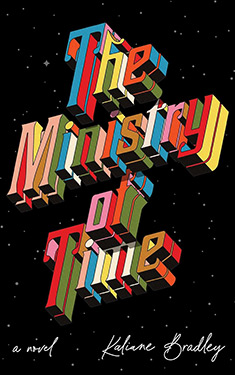
Added By: Administrator
Last Updated: Administrator
Holy Fire
| Author: | Bruce Sterling |
| Publisher: |
Orion Books, 1996 Bantam Spectra, 1996 |
| Series: | |
|
This book does not appear to be part of a series. If this is incorrect, and you know the name of the series to which it belongs, please let us know. |
|
| Book Type: | Novel |
| Genre: | Science-Fiction |
| Sub-Genre Tags: | Immortality Human Development Cyberpunk |
| Awards: | |
| Lists: | |
| Links: |
|
| Avg Member Rating: |
|
|
|
|
Synopsis
The 21st century is coming to a close, and the medical industrial complex dominates the world economy. It is a world of synthetic memory drugs, benevolent government surveillance, underground anarchists, and talking canine companions. Power is in the hands of conservative senior citizens who have watched their health and capital investments with equal care, gaining access to the latest advancements in life-extension technology. Meanwhile, the young live on the fringes of society, ekeing out a meagre survival on free, government-issued rations and a black market in stolen technological gadgetry from an earlier, less sophisticated age.
Mia Ziemann is a 94-year-old medical economist who enjoys all the benefits of her position. But a deathbed visit with a long-ago ex-lover and a chance meeting with a young bohemian dress-designer brings Mia to an awful revelation. She has lived her life with such caution that it has been totally bereft of pleasure and adventure. She has one chance to do it all over. But first she must submit herself to a radical--and painful--experimental procedure which promises to make her young again. The procedure is not without risk and her second chance at life will not come without a price. But first she will have to escape her team of medical keepers.
Hitching a ride on a plane to Europe, Mia sets out on a wild intercontinental quest in search of spiritual gratification, erotic revelation, and the thing she missed most of all: the holy fire of the creative experience. She joins a group of outlaw anarchists whose leader may be the man of her dreams... or her undoing. Worst of all, Mia will have to undergo one last radical procedure that could cost her a second life.
Excerpt
Mia opened the hinged lid of a glove font and dipped both her hands, up to the wrists, into a thick bath of hot adhesive plastic. She pulled her hands out, and waved them to cool and congeal.
The gloves crackled on her fingers as they cooled and set. Mia worked her finger joints, then clenched her fists, methodically. The plastic surface of the gloves split like drying mud into hundreds of tiny platelets. She then dipped her gloves into a second tank, then pulled free. Thin, conductive veins of wetly glittering organic circuitry dried swiftly among the cracks.
When her gloves were nicely done, Mia pulled a wrist-fan from a slot below the basin. She cracked the fan against her forearm to activate it, then opened it around her left wrist and buttoned it shut. The rainbow--tinted fabric stiffened nicely. When she had opened and buttoned her second wrist-fan, she had two large visual membranes the size of dinner plates radiating from the ends of her arms.
The plastic gloves came alive as their circuitry met and meshed with the undersides of the wrist-fans. Mia worked her fingers again. The wrist-fans swiftly mapped out the shape of the gloves, making themselves thoroughly familiar with the size, shape, and movements of her hands.
The fans went opaque. Her hands vanished from sight. Then the image of her hands reappeared, cleverly mapped and simulated onto the outer surfaces of the wrist-fans. Reality vanished at the rim of the fans, and Mia saw virtual images of both her hands extended into twin circles of blue void.
Tucking the touchslate under one arm, Mia left the bathroom and walked to her chosen curtain unit. She stepped inside and shut and sealed the curtain behind her. The fabric stiffened with a sudden top-to-bottom shudder, and the machine woke itself around her. The stiff curtain fabric turned a uniform shade of cerulean. Much more of reality vanished, and Mia stood suspended in a swimming sky blue virtuality. Immersive virtuality--except, of course, for the solid floor beneath her feet, and the ceiling overhead, an insect-elbowed mess of remote locators, tracking devices, and recording equipment.
The fabric curtain was woven from glass fiber. Thousands of hair-thin multicolored fiber-optic scan-lines. Following the cues from her false eyelashes, the curtain wall lit up and displayed its imagery wherever Mia's eyesight happened to rest. Wherever her gaze moved and fell, the curtain was always ahead of her, instantly illuminated, rendering its imagery in a fraction of a second, so that the woven illusion looked seamless, and surrounded her.
Mia fumbled for a jack and plugged in the touchslate. The curtain unit recognized the smaller machine and immediately wrapped her in a three-hundred-and-sixty-degree touchplate display, a virtual abyss of smoky gray. Mia dabbled at the touchscreen with her gloved fingertips until a few useful displays tumbled up from its glassy depths: a cycle tachometer, a clock, a network chooser.
She picked one of San Francisco's bigger public net gates, held her breath, and traced in Martin Warshaw's passtouch. The wall faithfully sketched out the scrawling of her gloved fingertip, monster glyphs of vivid charcoal against the gray fabric.
The tracing faded. The curtain unit went sky blue again. Nothing much happened after that. Still, the little tachometer showed processing churning away, somewhere, somehow, out in the depths of the net. So Mia waited patiently.
After eight minutes, the tachometer vanished. The walls went stellar black, then leapt into a full-scale virtuality rendition.
Mia found herself in an architect's office. There was a big desk in simulated wood grain, and painfillly gleaming brass lamps, and algorithmic swirls of simulated marble. The chairs were puffy, overstuffed, and swaddlingly comfortable. Old people's chairs. They were the kind of chairs that top-flight furniture designers had begun making back in the 2070s, when furniture designers suddenly realized that very old people possessed all the money in the world, and that from now on very old people were going to have all the money until the end of time.
The virtual office, with some fine display of irony, had been designed to resemble the office of a civil architect. Architects who designed actual buildings, as opposed to those who built virtual structures, tended to be rather snobbish and pushy about their intimate relation to tangible physicality. The walls around her were all corkboards, chalkboards, crayons, drafting paper, and string. All very analog and tactile. There wasn't a data screen anywhere in the place. Except, of course, that this entire virtual environment was itself a data screen.
There was a serious mismatch between Martin Warshaw's sophisticated memory palace and this randomly chosen and somewhat pokey little curtain unit. Against the rounded fabric walls, the corners of the virtual room looked quite nasty, with a stomach-churning visual warp. The simulation couldn't seem to decide where to put the floor. Rims of flooring slopped up on the lower edges of the screen, like a swamped rowboat slowly going under.
A simulated window in one wall showed an arty glimpse of a fake exterior garden, but the organic shapes within the garden were disastrous. The trees were jerky half-rendered blurs, a nightmare vision of x-rayed vegetation under alien sunlight as thick as cheese. The inside of the office boasted a virtual potted plant. Its big serrated leaves looked as stiff and lifeless as waffle irons.
Mia turned in place, gazing about the virtual office cautiously. A massive framed blueprint hung on the wall to her left. It showed a vast multistory edifice--the ground-floor plans of the memory palace itself, presumably. The blueprints were lavishly annotated, in horribly blurred and tiny print. The palace looked huge, elaborate, and quite intimidating. Mia felt as if she'd unwrapped a Christmas gift and found an entire steam locomotive crammed inside it. A multiton coal-fired virtual jack-in-the-box.
She turned toward the center of the room. The top of the wood-grain desk boasted a single framed photograph. Mia made stepping motions in place, and managed to reach the virtual desk without barging through it. She reached out one hand, fishing for the photo. The glove interface was hopelessly bad, full of stutter and overlap.
This was a very unhappy interface. And small wonder. No doubt this entire virtual environment was being encrypted, decrypted, reencrypted, anonymously routed through satellites and cables, emulated on alien machinery through ill-fitting, out-of-date protocols, then displayed through long-dead graphics standards.
Dismembered, piped, compressed, packeted, unpacketed, decompressed, unpiped and remembered. Worse yet, the place was old.
Virtual buildings didn't age like physical ones, but they aged in subtle pathways of arcane decline, in much the way that their owners did. A little bijou table in the corner had a pronounced case of bit-rot: from a certain angle it lost all surface tint.
The place wasn't dead, though. A virtual gecko appeared and sneaked its way along the wall, a sure sign that little health-assuring subroutines were still working their way through the damper, darker spots in the palace's code.
Mia got a tentative grip on the photograph. She lifted it from the desktop, and the image burst free from the frame like a hemorrhage, and leapt up onto the fabric wall of the curtain unit, flinging itself all around her in a three-hundred-and-sixty-degree blast of bright red pixels the size of bloody thumbprints. Mia winced, put the photo back down, and peered at it sidelong through the membrane of her wrist-fan. Objects within hand's reach seemed a lot better realized graphically than the jittery mess up on the curtain walls.
The frame held another digital photograph of herself. A different picture this time: the very young Mia Ziemann was sitting on a threadbare red fabric couch in her red terry-cloth bathrobe, reading a paper magazine, her slim bare legs perched on a coffee table. Her hair was wet. The floor was littered with collegiate junk: fast-food packets, disks of recorded music, two unlaced walking shoes. The young Mia was unaware of the photographer. She looked relaxed and comfortable, yet deeply intent on her magazine.
Another little keepsake of Martin's. His posthumous message to the palace's chosen heiress.
Mia clawed open a drawer of the virtual desk. Empty. She knocked the photo into the empty drawer and shut it.
She opened another desk drawer. Scissors, paper, pens, tape, pins. She tried repeatedly, but failed to get a decent grip on the virtual scissors. She opened another drawer. A box of colored chalk.
Mia plucked a stick of pale green chalk from the box, and turned toward the chalkboard on the far wall. She marched in place toward the chalkboard--it reeled disturbingly as she grew nearer--and she reached out, her gloved fingers pinched and the virtual chalk outstretched.
Clearly this action called for much better gloves than the cheap peel-aways she was wearing. The chalk wobbled in and out of the surface of the chalkboard like Dodgson's Alice having fits in a mirror. After prolonged struggle Mia managed to shakily scrawl a random message, the first thing that had come into her head
Copyright © 1996 by Bruce Sterling
Reviews
There are currently no reviews for this novel. Be the first to submit one! You must be logged in to submit a review in the BookTrackr section above.
Images
No alternate cover images currently exist for this novel.



















 Full Details
Full Details






